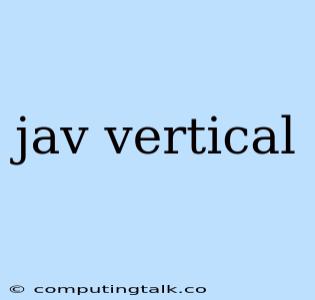Understanding and Utilizing Java Vertical
Java vertical, a term that often arises in the context of software development, particularly within Java-based applications, can be confusing at first glance. It's not a specific Java feature or library, but rather a concept that describes a way of structuring and organizing Java code. It's about breaking down your Java application into distinct, self-contained units, each responsible for a specific aspect or function. Think of it like creating different departments in a company, each with its own specialized role and responsibility.
What are the benefits of using a Java vertical approach?
- Enhanced Code Organization: By dividing your Java code into verticals, you achieve a clear separation of concerns, making your code easier to understand, navigate, and maintain. This is crucial for large, complex applications where managing a sprawling codebase can be a nightmare.
- Improved Reusability: Each vertical acts as a self-contained module, promoting code reusability across your project. This saves time and effort by avoiding redundant code and encouraging the use of shared components.
- Simplified Testing: Testing becomes more manageable as you can test each vertical in isolation, focusing on its specific functionality without interference from other parts of your application.
- Streamlined Collaboration: When working in teams, using a vertical structure allows developers to focus on specific functionalities, ensuring a clear division of labor and reducing conflicts.
How do I implement a Java vertical structure?
- Identify Your Verticals: Start by analyzing your application and identifying the key functionalities or domains. These could be things like user management, data storage, payment processing, or specific business logic.
- Create Separate Packages: For each vertical, create a dedicated package within your project. This physical separation helps reinforce the modularity of your code.
- Define Interfaces and Dependencies: Ensure clear communication between verticals by defining interfaces that specify how they interact. This promotes loose coupling, making your code more flexible and adaptable to future changes.
- Implement Core Functionality: Within each vertical's package, implement the specific functionalities, keeping the code focused on its assigned role.
- Introduce Dependency Injection: Leverage dependency injection frameworks like Spring or Guice to manage the dependencies between verticals. This allows for easier testing and promotes modularity.
Example:
Let's say you're building an e-commerce application. You might define these verticals:
- User Management: Handles user registration, authentication, and profile management.
- Product Catalog: Manages the listing, search, and display of products.
- Order Processing: Handles order placement, payment processing, and fulfillment.
Each vertical would have its own package, interfaces, and implementations, ensuring a clean separation of concerns and making the application easier to manage and extend.
How does Java vertical fit into the bigger picture?
The concept of Java vertical is not just a coding technique, but a design principle that aligns with broader architectural patterns like microservices. By breaking down your application into smaller, independent units, you create a more flexible and scalable system. These independent units can even be deployed separately, allowing for faster development cycles and easier maintenance.
In Conclusion:
Java vertical is a powerful tool for building well-structured, maintainable, and scalable Java applications. By breaking down your application into smaller, independent units, you achieve a clear separation of concerns, improve reusability, streamline testing, and enhance collaboration. While it might require a bit more initial planning, the long-term benefits far outweigh the effort. Remember, a well-organized codebase is the foundation of a successful Java application!
